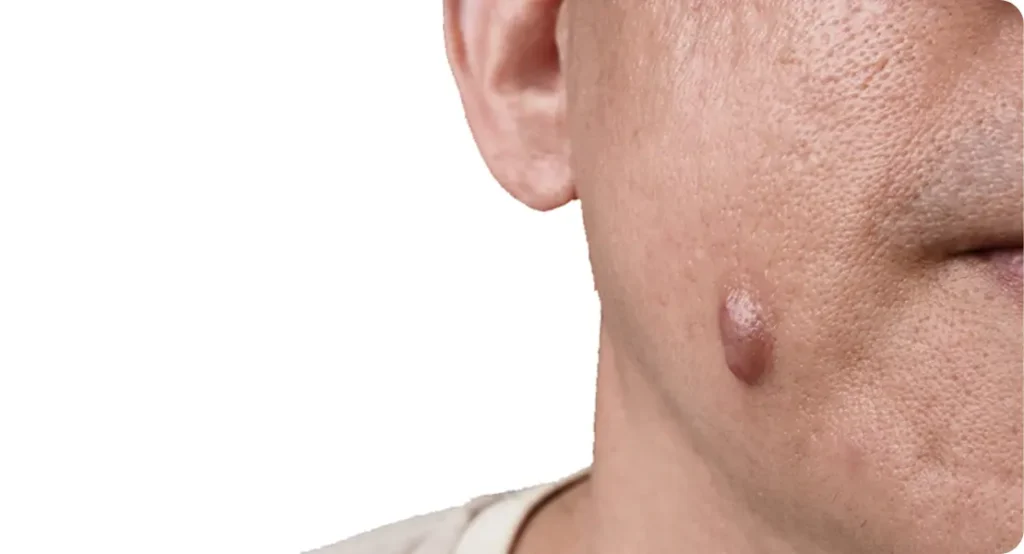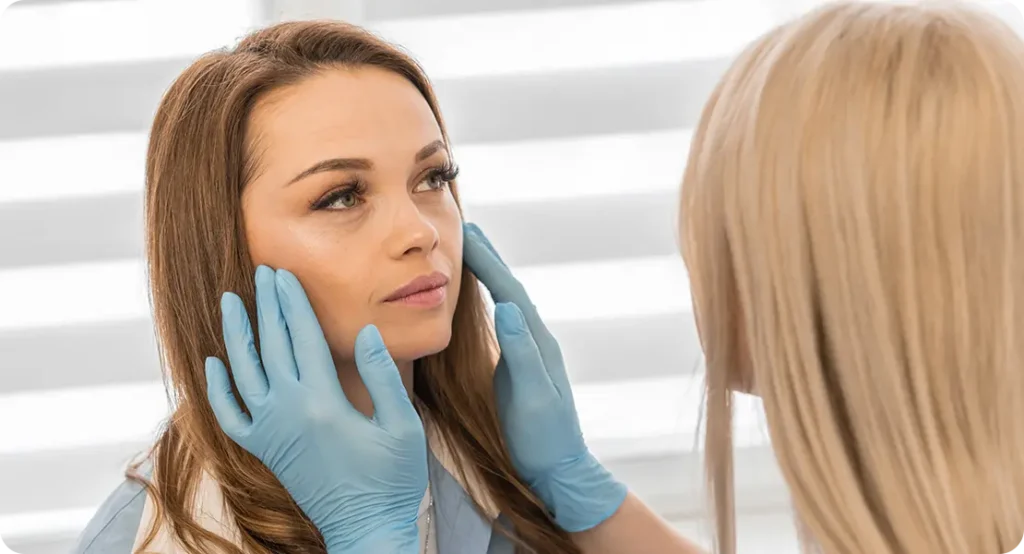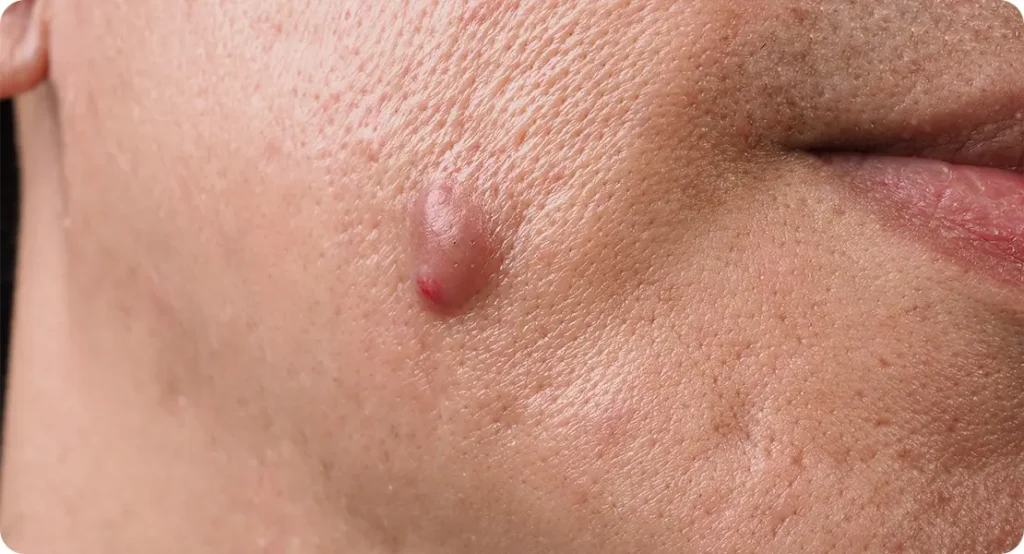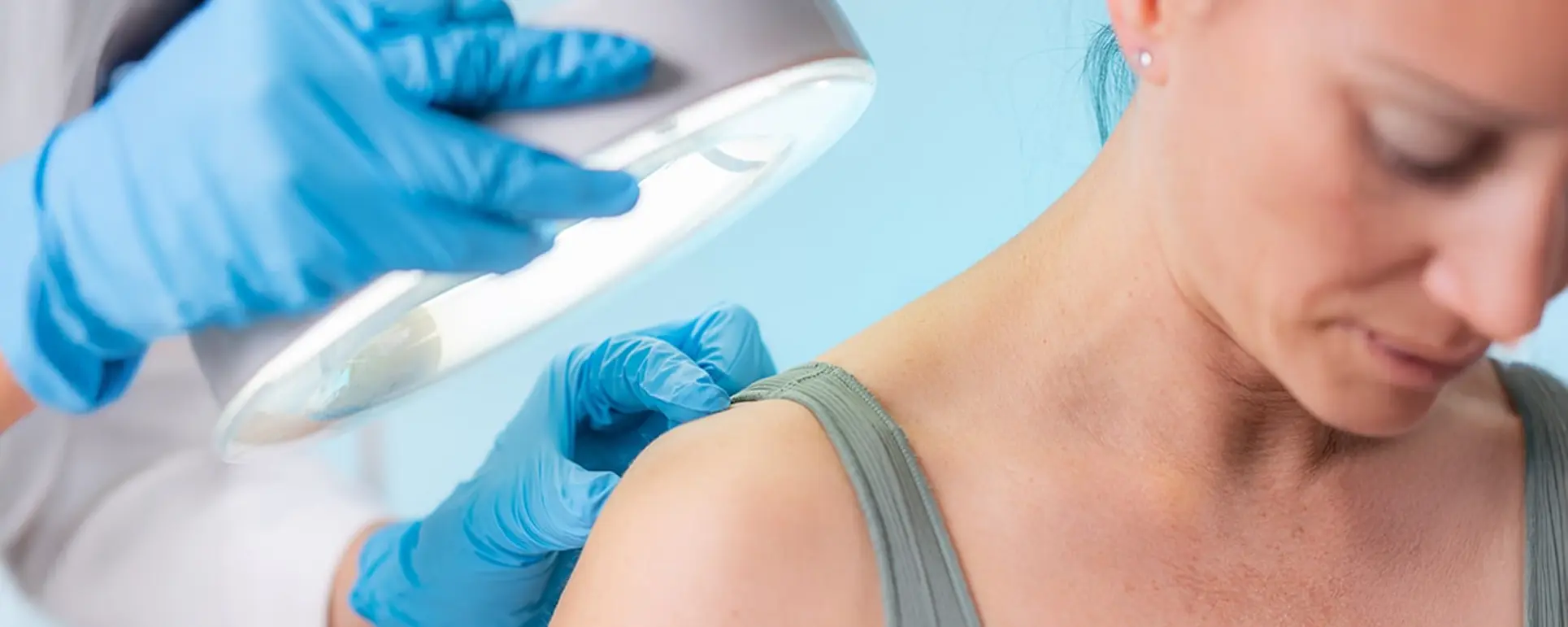Cysts are common skin growths, often harmless but sometimes painful, unsightly, or prone to infection. While your local GP may be your first port of call when one appears, they’re rarely the best person to deal with it—especially if it’s on your face. Cyst removal may seem simple on the surface, but poor handling can lead to scarring, recurrence, or infection. These risks are particularly high when cysts are misdiagnosed or incompletely removed. Dermatologists are uniquely qualified to assess and treat cysts safely and with cosmetic outcomes in mind. Here’s why you should leave it to a dermatologist.
What Exactly Is a Cyst?
A cyst is a sac-like pocket of tissue that can be filled with fluid, pus, or other material. They can form anywhere on the body but are especially common on the face, neck, back, and scalp. The most frequent types include sebaceous (epidermoid) cysts and pilar cysts. While usually benign, they can become inflamed, infected, or cosmetically distressing—particularly when they’re on visible parts of the body. That’s when professional removal becomes important. Some cysts can also grow larger over time or rupture, which leads to more discomfort and greater risk of scarring. Although home remedies might seem appealing, they often make matters worse. Having a cyst properly identified and removed by a dermatologist ensures it’s dealt with safely and effectively.
Why Your GP Isn’t the Right Person for the Job
General Practitioners are skilled at diagnosing and managing a wide range of medical conditions. However, most GPs are not equipped—or trained—for surgical cyst removal, especially in sensitive areas like the face. They might lance or drain a cyst, which provides temporary relief but rarely removes the root cause. This can lead to recurrence or scarring. Worse, if the cyst is misdiagnosed and treated incorrectly, it can delay proper care. GPs also lack the specialist tools and sterile conditions needed for more delicate removals. Dermatologists, on the other hand, have extensive training in skin surgery and understand how to minimise damage to surrounding tissue, making them the safest choice for both medical and cosmetic outcomes.
The Risks of Non-Specialist Removal
Removing a cyst improperly can do more harm than good. If the sac wall of the cyst isn’t completely removed, it will likely grow back. GPs, lacking access to the right tools or sterile environments, may attempt a quick drainage rather than full excision. This increases the chance of:
- Infection
- Inflammation
- Scarring
- Recurrence
In some cases, the cyst may even burst under the skin, causing further irritation or abscess formation. These complications are particularly concerning when the cyst is on the face, where the margin for error is slim.
Why You Need a Dermatologist
Dermatologists are skin specialists trained in both the diagnosis and surgical management of skin conditions, including cysts. They understand the underlying causes, can identify whether a growth is truly benign, and use sterile, precise techniques to remove it fully. This ensures the best possible cosmetic outcome and reduces the risk of recurrence.
Most dermatologists also have access to minor surgical suites or outpatient facilities designed specifically for these procedures. This controlled environment further minimises the risk of complications and ensures the cyst is removed under local anaesthetic, quickly and safely.
Diagnosis First: Not Every Lump Is a Cyst
One key reason not to rely on your GP for cyst removal is the risk of misdiagnosis. What appears to be a harmless cyst could be something else entirely—such as a lipoma, abscess, or even a skin cancer. Dermatologists are trained to differentiate these and may carry out a biopsy if there’s any doubt. Early and accurate diagnosis is vital, particularly when dealing with lesions on the face or scalp. Misidentifying a growth can lead to delayed treatment or inappropriate removal techniques that make things worse.
Facial Cysts Need Special Care
Cysts on the face deserve specialist attention. The skin here is thinner, the risk of scarring is higher, and the cosmetic stakes are greater. Removing a facial cyst isn’t just a medical issue—it’s a cosmetic one too. Dermatologists consider both factors and use techniques designed to minimise visible scarring. This may include using hidden incisions, layered sutures, and fine stitching under magnification. Such precision is rarely possible in a GP surgery, where cosmetic outcomes may not be prioritised.

The Importance of a Sterile Environment
Sterility is critical during any surgical procedure, even a seemingly minor one like cyst removal. Non-sterile conditions can introduce bacteria into the site, increasing the risk of infection and delayed healing. Dermatologists operate in sterile environments, with trained support staff and properly disinfected instruments. This dramatically lowers the risk of post-operative infection compared to treatment in a GP’s office or urgent care setting. A clean, controlled environment is essential for safe and successful outcomes.
What to Expect from Dermatological Removal
If you visit a dermatologist for cyst removal, you’ll typically have an assessment appointment followed by a minor procedure under local anaesthetic. The cyst will be carefully excised, including the entire sac wall, to ensure it doesn’t return. You’ll be given aftercare advice and possibly a follow-up appointment to check healing. In most cases, the scar is small and fades well over time—particularly if it was treated early and properly. The thoroughness of this approach significantly reduces the chance of recurrence.
Preventing Cyst Recurrence
Dermatologists don’t just remove cysts—they can help prevent them from coming back. If your skin is prone to cysts, they may recommend medical-grade skincare, oral treatments, or even minor surgery to remove blocked ducts or follicles. Understanding why a cyst has formed in the first place is essential for preventing future ones—and GPs often don’t delve that deep. A specialist-led plan can address the root cause, not just the visible lump.
When to See a Dermatologist
You should see a dermatologist if:
- The cyst is painful, infected, or rapidly growing
- It’s located on your face, scalp, or genitals
- You’ve had it treated before but it keeps coming back
- You want the best cosmetic outcome
- You’re unsure whether the lump is a cyst
Waiting too long or attempting DIY treatments can make things worse. Dermatological intervention is quicker, cleaner, and more effective in the long run.
Understanding Different Types of Cysts
Not all cysts are the same, and understanding their type can affect how they’re treated. Epidermoid cysts, often mistaken for sebaceous cysts, form from trapped skin cells. Pilar cysts are usually found on the scalp and tend to run in families. Sebaceous cysts are rarer and originate from oil glands. Each type has its own removal considerations, which dermatologists are trained to recognise. Treating all cysts the same way—by draining or squeezing—can lead to complications. That’s why expert diagnosis is vital. Without knowing what kind of cyst you’re dealing with, you can’t ensure the most appropriate treatment approach.
The Problem with “Dr Pimple Popper” DIY Culture
The rise of online videos showing cyst removals has made DIY attempts more common—but also more dangerous. People try to pop or drain cysts at home using pins, tweezers, or worse. This not only increases the risk of infection but often leaves the cyst partially intact, ensuring it will come back. Dermatologists frequently treat patients who’ve worsened their condition by trying to deal with it themselves. What might have been a quick and clean removal becomes a painful, swollen, or scarred mess. Cyst removal isn’t entertainment—it’s a medical procedure that should be done by a trained professional.
Cosmetic Outcomes Matter More Than You Think
When a cyst is removed, it leaves a scar—but how visible that scar is depends heavily on who does the removal. Dermatologists are trained to minimise scarring using fine instruments and delicate stitching techniques. GPs or walk-in clinics may not have the tools or experience to do the same. Especially on the face, neck, or other visible areas, the cosmetic result matters. Poor technique can leave a dent, raised scar, or even keloid tissue. A dermatologist balances medical removal with cosmetic care, aiming for a result that looks as good as it feels.
Insurance and Private Dermatology Options
In the UK, the NHS may not always cover cyst removal if it’s deemed cosmetic or non-urgent. As a result, patients often face long waiting lists—or may be refused treatment altogether. In these cases, seeking private dermatology care can be the quickest, safest option. Many clinics offer same-week appointments for minor surgical procedures, and the cost is often more affordable than people expect. You’ll also benefit from a consultation, expert aftercare, and a more comfortable setting. Investing in private care may save you time, stress, and long-term issues associated with poor or delayed treatment.
Recurrence Isn’t Just Bad Luck—It’s Bad Removal
If your cyst keeps coming back, it’s probably because it wasn’t properly removed the first time. A cyst has a sac or capsule under the skin, and if that’s not fully excised, it can fill up again. This is a common issue when cysts are drained or lanced without full removal. Dermatologists understand the structure of cysts and use surgical techniques designed to eliminate them completely. This reduces the chances of recurrence dramatically. If you’ve had repeat issues with the same cyst, it’s time to seek specialist care and finally put an end to the cycle.

When Cyst Removal Goes Wrong
When cysts aren’t removed properly, complications are common. If the entire cyst sac isn’t taken out, it can refill, becoming larger or more painful over time. Rupturing the sac during removal—especially in non-specialist settings—can spread its contents into surrounding tissues, leading to infection, inflammation, or the formation of an abscess. Inadequate removal also increases the risk of long-term scarring or disfigurement. Unfortunately, GPs or walk-in clinics may lack the surgical expertise and sterile setup to handle complex cysts. This often results in repeat procedures or referrals to dermatologists after damage is done. Avoiding improper removal saves time, discomfort, and cost.
Children and Teenagers Need Extra Caution
Cyst removal in children or teenagers demands a gentler, more specialised approach. Young skin is more delicate, and the psychological effects of visible scarring can be long-lasting. Early acne-related cysts may also be mismanaged without input from a dermatologist. Specialists understand how to adapt techniques to younger patients and assess whether removal is truly necessary. Where possible, they may recommend non-surgical options or delay procedures to reduce trauma. Facial cysts, in particular, require extreme care. Choosing expert care from the outset not only protects the child’s skin—it supports their confidence and overall wellbeing during critical developmental years.
Avoiding DIY and ‘Quick Fix’ Treatments
It’s tempting to squeeze or pop a cyst at home, especially if it’s painful or unsightly. But doing so can lead to serious problems—introducing infection, worsening inflammation, or causing permanent scarring. Online ‘hacks’ like hot compresses, toothpaste, or needles are not only ineffective but potentially harmful. Even over-the-counter creams rarely address the actual cause. Attempting to fix it yourself may make future treatment more difficult. Dermatologists, on the other hand, can safely assess and remove cysts in a sterile setting. Professional treatment is the only truly effective way to resolve the problem and protect your skin.
Understanding the Root Cause of Repeated Cysts
If you frequently develop cysts, there may be an underlying reason—something GPs don’t always investigate. Recurrent cysts could be linked to blocked hair follicles, sebaceous gland issues, or chronic skin conditions like acne or hidradenitis suppurativa. Dermatologists look at the full picture, identifying possible causes through examinations, swabs, or imaging. Once a pattern is identified, they can develop a treatment plan that goes beyond removal—preventing further breakouts. This might include skincare changes, oral medication, or minor surgical interventions. Understanding why cysts keep forming is the first step toward long-term skin health and reducing repeated visits.
Peace of Mind from Specialist Care
Beyond surgical skill, dermatologists offer reassurance and clarity. When you see a skin specialist, you’re not left guessing whether a lump is serious or whether the removal will leave a scar. Dermatologists provide clear diagnoses, safe removal, and tailored aftercare—especially important when cysts occur on visible areas like the face or neck. You’ll also get advice on preventing recurrence, which GPs may not be equipped to provide. Having expert care gives you confidence that your skin is being looked after properly. For many patients, that peace of mind is just as important as the procedure itself.

The Risk of Scarring and Poor Cosmetic Results
Facial cysts, in particular, require a specialist’s touch to avoid noticeable scarring. GPs may not be trained in cosmetic closure techniques such as layered suturing or using discreet incision points. This can lead to uneven skin texture or visible marks, especially on delicate facial skin. Dermatologists not only remove the cyst but do so in a way that preserves your appearance. They understand skin tension lines and use precision tools under magnification to reduce trauma. For patients concerned about aesthetics—as many are—choosing an expert from the start is a decision that pays off both medically and cosmetically.
Infection and Inflammation: A Common Complication
Cysts that are squeezed, drained improperly, or left partially removed can easily become infected. Once bacteria enter the site, the area can swell, redden, and become painful—sometimes developing into an abscess that requires emergency treatment. Infections not only cause discomfort but can increase the likelihood of scarring and delay healing. Dermatologists take every precaution to avoid this by using sterile techniques, prescribing antibiotics when needed, and offering post-procedure guidance to support optimal recovery. Avoiding infection isn’t just about comfort—it’s about ensuring the skin heals cleanly and without long-term consequences.
When a Cyst Could Be Something More
Not all lumps are benign cysts. Some skin growths may mimic cysts but turn out to be lipomas, inflamed acne nodules, or in rare cases, skin cancers. GPs may not always have the training or tools to differentiate between these, especially without biopsy or dermatoscopic examination. Dermatologists are trained to spot subtle signs that suggest further investigation is needed. If there’s any uncertainty, they can quickly arrange for lab analysis or refer for additional testing. Getting an accurate diagnosis early on can make a significant difference, particularly for lesions on the face or scalp where missteps can be costly.

Final Words
Cysts might be common, but that doesn’t mean they should be treated casually. When it comes to removal—especially on your face—expert care is essential. Your GP plays an important role in your overall health, but cyst removal is best left to those with specialist training.
Dermatologists offer the precision, safety, and aesthetic sensitivity needed for proper treatment. Don’t settle for a quick fix—opt for expert care. The right intervention not only removes the cyst safely but also protects your appearance, reduces the risk of recurrence, and ensures the underlying cause is addressed. Long-term skin health starts with the right decision today.
If you would like help removing a cyst, you can get in touch with us at The London Dermatology Centre to consult with one of our expert surgical dermatologists.
References:
- DermNet NZ, 2018. Epidermoid cysts. [online] Available at: https://dermnetnz.org/topics/epidermoid-cyst [Accessed 13 May 2025].
- British Association of Dermatologists (BAD), 2020. Skin Surgery: Information for patients. [online] Available at: https://www.bad.org.uk/pils/skin-surgery/ [Accessed 13 May 2025].
- National Health Service (NHS), 2023. Skin cysts. [online] Available at: https://www.nhs.uk/conditions/skin-cyst/ [Accessed 13 May 2025].
- Habif, T.P., 2016. Clinical Dermatology: A Color Guide to Diagnosis and Therapy. 6th ed. Philadelphia: Elsevier.
- Zuber, T.J. and Baddam, K., 2017. Management of epidermal inclusion cysts. American Family Physician, 95(5), pp.293–294.
